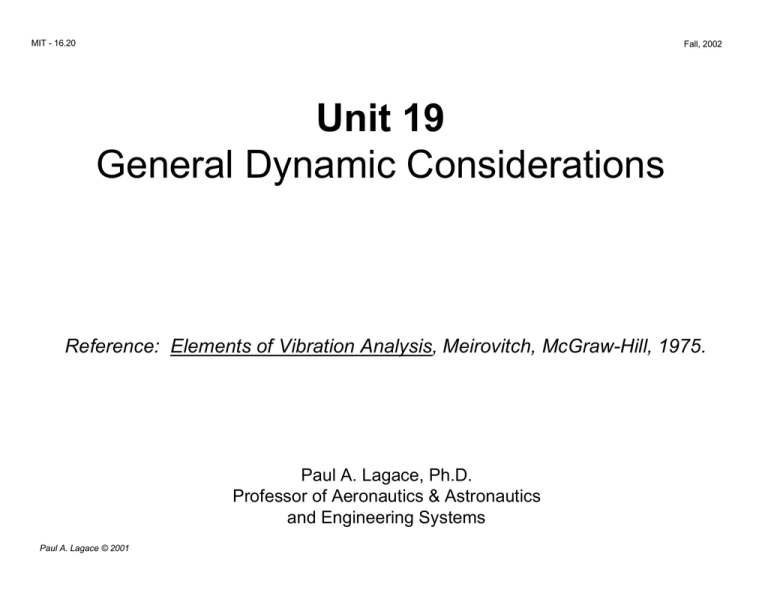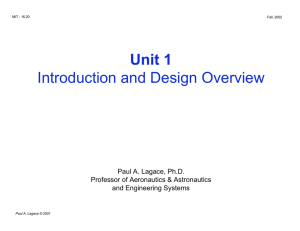Document 13475867
advertisement

MIT - 16.20 Fall, 2002 Unit 19 General Dynamic Considerations Reference: Elements of Vibration Analysis, Meirovitch, McGraw-Hill, 1975. Paul A. Lagace, Ph.D. Professor of Aeronautics & Astronautics and Engineering Systems Paul A. Lagace © 2001 MIT - 16.20 Fall, 2002 VI. (Introduction to) Structural Dynamics Paul A. Lagace © 2001 Unit 19 - 2 MIT - 16.20 Fall, 2002 Thus far have considered only static response. However, things also move, this includes structures. Can actually identify three “categories” of response: A. (Quasi) - Static [“quasi” because the load must first be applied] B. Dynamic C. Wave Propagation What is the key consideration in determining which regime one is in? --> the frequency of the forcing function Example: Mass on a Spring Figure 19.1 Paul A. Lagace © 2001 Representation of mass on a spring Unit 19 - 3 MIT - 16.20 Fall, 2002 A) Push very slowly Figure 19.2 Representation of force increasing slowly with time t = time The response is basically determined by: F = kq F (t ) F ≈ k k Deflection response versus time for mass in spring with loads slowly increasing with time ⇒ q (t ) = Figure 19.3 (F/k) at any point Paul A. Lagace © 2001 Unit 19 - 4 MIT - 16.20 Fall, 2002 B) Push with an oscillating magnitude Figure 19.4 Representation of force with oscillating magnitude The response also oscillates Figure 19.5 Paul A. Lagace © 2001 Representation of oscillating response Unit 19 - 5 MIT - 16.20 Fall, 2002 C) Whack mass with a hammer ⇒ Force is basically a unit impulse Figure 19.6 Representation of unit impulse force Force has very high frequencies Response is (structural) waves in spring with no global deflection Paul A. Lagace © 2001 Unit 19 - 6 MIT - 16.20 Fall, 2002 --> Represent this as Figure 19.7 Representation of regions of structural response versus frequency of forcing function (Quasi) - Static Dynamics Wave Propagation Static What determines division points between regimes? --> borderline between quasi-static and dynamic is related to natural frequency of structure. Depends on: • structural stiffness • structural “characteristic length” --> gives natural frequency of structure --> borderline between dynamic and waves is related to speed of waves (sound) in material. Depends on: • modulus • density speed = E ρ Paul A. Lagace © 2001 Unit 19 - 7 MIT - 16.20 Fall, 2002 --> These are not well-defined borderlines • depends on specifics of configuration • actually transition regions, not borders • interactions between behaviors So illustration is: Figure 19.8 Representation of regions of structural response versus frequency of forcing function (Quasi) - Static Static (Structural) Dynamics f(natural frequency of structure) Wave Propagation f(speed of waves in material) = region of transition Paul A. Lagace © 2001 Unit 19 - 8 MIT - 16.20 Fall, 2002 Statics -- Unified and 16.20 to date Waves -- Unified (Structural) Dynamics -- 16.221 (graduate course). Look at what we must include/add to our static considerations Consider the simplest ones… The Spring-Mass System Are probably used to seeing it as: Figure 19.9 General representation of spring-mass system Paul A. Lagace © 2001 Unit 19 - 9 MIT - 16.20 Fall, 2002 For easier relation to the structural configuration (which will later be made), draw this as a rolling cart of mass attached to a wall by a spring: Figure 19.10 Alternate representation of spring-mass system [Force/length] k • The mass is subjected to some force which is a function of time • The position of the mass is defined by the parameter q • Both F and q are defined positive in the positive x-direction Static equation: F = kq • What must be added in the dynamic case? Inertial load(s) = - mass x acceleration In this case: inertial load = − m q̇˙ Paul A. Lagace © 2001 Unit 19 - 10 MIT - 16.20 Fall, 2002 where: d ( ) d t (derivative with respect to time) Drawing the free body diagram for this configuration: Figure 19.11 Free body diagram for spring-mass system • ∑F = = 0 ⇒ F − k q − m q˙˙ = 0 ⇒ m q̇˙ + k q = F (t ) Basic spring-mass system (no damping) This is a 2nd order Ordinary Differential Equation in time. When the Ordinary/Partial Differential Equation is in space, need Boundary Conditions. Now that the Differential Equation is in time, need Initial Conditions. Paul A. Lagace © 2001 Unit 19 - 11 MIT - 16.20 Fall, 2002 2nd Order ⇒ need 2 Initial Conditions Here: @ t = 0 q = q0 q˙ = q̇0 some initial values given (may often be zero) Will look at how to solve this in the next unit. There is another consideration that generally occurs in real systems -DAMPING. For the spring-mass system, this is represented by a dashpot with a constant c which produces a force in proportion to the velocity: Figure 19.12 Representation of spring-mass system with damping [Force/length] [Force/length/time] Paul A. Lagace © 2001 Unit 19 - 12 MIT - 16.20 Fall, 2002 Here the free body diagram is: Figure 19.13 Free body diagram of spring-mass system with damping ∑F = 0 ⇒ m q̇˙ + c q̇ + k q = F (t ) Basic spring-mass system (with damping) From here on: neglect damping Can build on what has been done and go to a… Paul A. Lagace © 2001 Unit 19 - 13 MIT - 16.20 Fall, 2002 Multi-Mass System For example, consider two masses linked by springs: Each mass has stiffness, (ki) mass (mi) and force (Fi) with associated deflection, qi Figure 19.14 Representation of multi-mass (and spring) system Consider the free body diagram for each mass: Paul A. Lagace © 2001 Unit 19 - 14 MIT - 16.20 Fall, 2002 • Mass1 Figure 19.15 Face body diagram of Mass 1 in multi-mass system ∑F = 0 yields: F1 + k2 (q2 − q1 ) − k1 q1 − m1 q˙˙1 = 0 Paul A. Lagace © 2001 Unit 19 - 15 MIT - 16.20 Fall, 2002 • Mass 2 Figure 19.16 Free body diagram of Mass 2 in multi-mass system ∑F = 0 yields: F2 − k2 (q2 − q1 ) − m2 q˙˙2 = 0 Rearrange and unite these as (grouping terms): m1 q̇˙1 + (k1 + k2 )q1 − k2 q2 = F1 m2 q˙˙2 − k2 q1 + k2 q2 = F2 --> Two coupled Ordinary Differential Equations Paul A. Lagace © 2001 Unit 19 - 16 MIT - 16.20 Fall, 2002 Write in matrix form: F1 m1 0 q˙˙1 (k1 + k2 ) −k2 q1 q = F 0 m q˙˙ + −k k2 2 2 2 2 2 or: mq̇˙ + kq = F ~~ ~~ ~ mass stiffness matrix matrix Note that the stiffness matrix is symmetric (as it has been in all other considerations) kij = k ji This formulation can then be extended to 3, 4….n masses with mi = mass of unit i ki = stiffness of spring of unit i qi = displacement of unit i Fi = force acting on unit i etc. Paul A. Lagace © 2001 Unit 19 - 17 MIT - 16.20 Fall, 2002 Will next consider solutions to this equation. But first talk about why these considerations are important in structures. First issue -- what causes such response are: Dynamic Structural Loads Generic sources of dynamic loads: • • • • Wind (especially gusts) Impact Unsteady motion (inertial effects) Servo systems • • • How are these manifested in particular types of structures? Paul A. Lagace © 2001 Unit 19 - 18 MIT - 16.20 Fall, 2002 Aircraft • Gust loads and turbulence flutter (aeroelasticity is interaction of aerodynamic, elastic and inertial forces) • Servo loads (and aero loads) on control surfaces Spacecraft Paul A. Lagace © 2001 Unit 19 - 19 MIT - 16.20 Fall, 2002 Automobiles, Trains, etc. Civil Structures Earthquakes and Buildings What does this all result in? A response which is comprised of two parts: • rigid-body motion • elastic deformation and vibration of structure Paul A. Lagace © 2001 Unit 19 - 20 MIT - 16.20 Fall, 2002 Note that: • Peak dynamic deflections and stresses can be several times that of the static values • Dynamic response can (quickly) lead to fatigue failure (Helicopter = a fatigue machine!) • Discomfort for passengers (think of a car without springs) So there is a clear need to study structural dynamics Before dealing with the continuous structural system, first go back to the simple spring-mass case and learn: • Solutions for spring-mass systems • How to model a continuous system as a discrete spring-mass system then… • Paul A. Lagace © 2001 Extend the concept to a continuous system Unit 19 - 21




